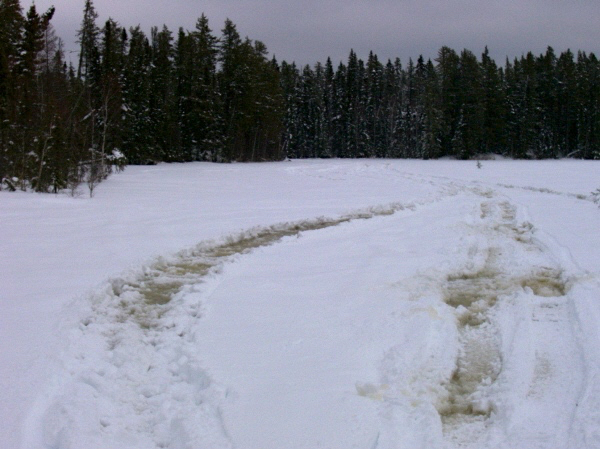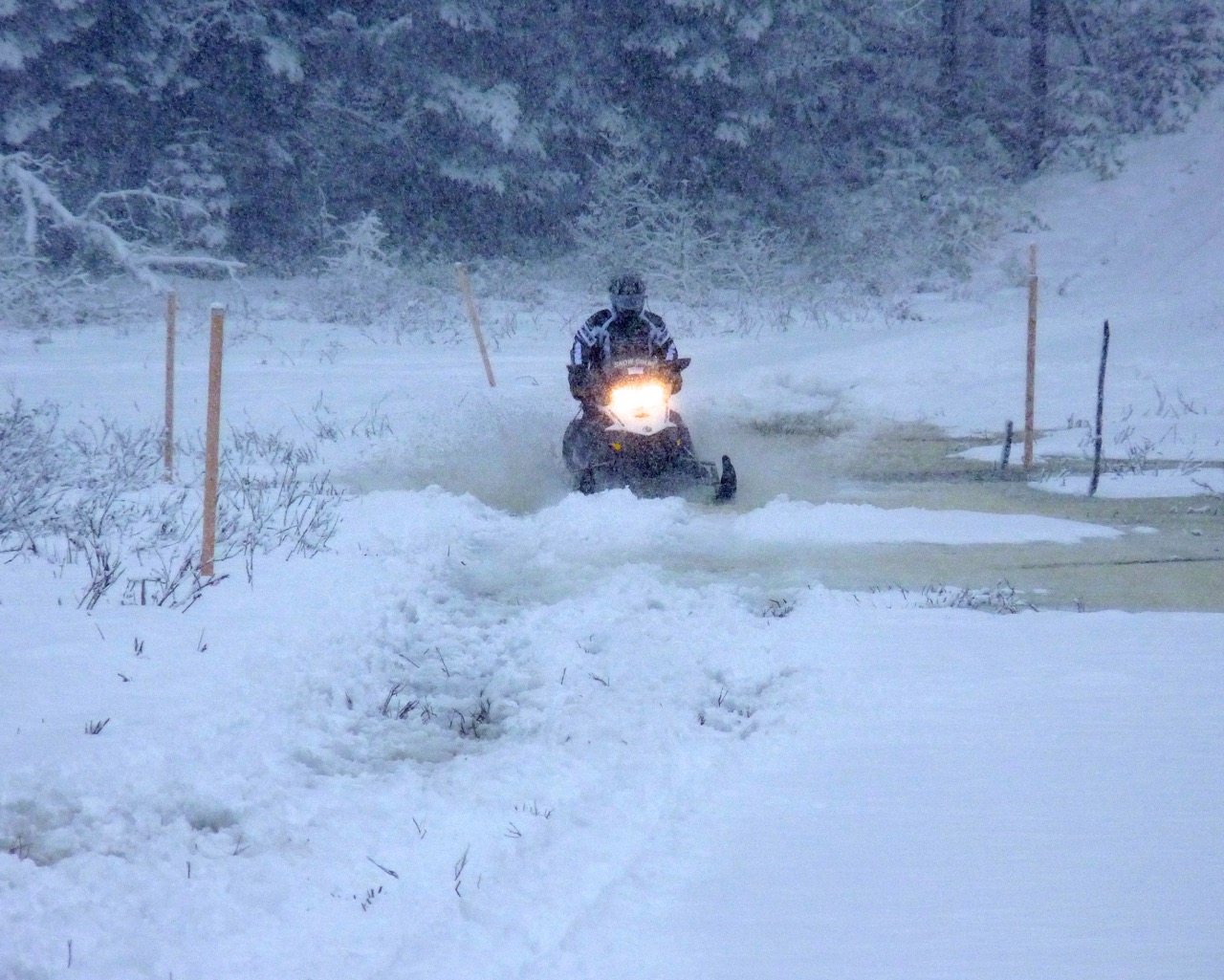How To Avoid Getting Trapped By The Slush Monster…

Photo credit: Snowmobile Forum
Related: Ice Riding Tips
So why do you need any best slush snowmobiling tips? Because unless you absolutely never snowmobile across ice, you may suddenly encounter that soupy goop hidden under the snow. It’s the quicksand of snowmobiling…
A friend of mine did the Northern Ontario adventure ride from Cochrane to Moosonee. But it was even more of an experience than his group bargained for. Everyone knew the last 100 kilometres into Moosonee was on the frozen Moose River. What the group hadn’t counted on was running slush all the way. So, unable to stop for a break because of the river’s steep and rocky banks, they white-knuckled it for a 100 klicks, never letting off the gas for fear of getting stuck.
This is an extreme example of a slush encounter. Typically, you’ll run into slush where you can get off it sooner than on the Moose River. Slush is normally found most often on small lakes or in bays. But it can occur on any size or shape of waterbody.
For instance, one of my most unnerving slush experiences was on a large, long lake Northwestern Ontario. We rode the first half without incident into a gas station to fill up. Upon leaving, the rest of the lake turned in a different direction and its snow cover looked just the same. Then without any warning, the sleds ahead started throwing up rooster tails of slush as their tracks cut through the snow into goop.
Was it the extra weight of the full fuel tanks? Who knows, but there were some heart-in-throat moments when one sled or another would start to bog down. Fortunately, no one got seriously stuck. Regardless, whenever you encounter slush, my best slush snowmobiling tips can help save your ride.

Photo Credit: BayToday.com
Best Slush Snowmobiling Tips #1
If a sled in front of you cuts a track of open slush, steer your snowmobile onto unbroken snow if possible. Don’t follow in an open slush track.
Best Slush Snowmobiling Tips #2
Don’t stop, slow down or attempt any tight turns.Why? Because the weight of your sled is more likely to sink into the slush at lower speed and trap your track. (Note: not stopping is the reason I don’t have any great sleds stuck in slush photos!)
Best Slush Snowmobiling Tips #3
Stay on the throttle with enough speed to keep your sled on top of the slush, Then hightail it back on to solid snow or to the shore.
Best Slush Snowmobiling Tips #4
If you do feel your sled beginning to bog down, try rocking your back end side to side as you continue to ride. This action may help keep your track free from the goop.
Best Slush Snowmobiling Tips #5
If your group hits slush, it’s each rider’s job to make it out on their own if possible. Why? Because anyone who stops to help is also likely to get struck. After you reach safe snow or shore, stop to check if everyone made it. If not, make a plan about how to assist stuck companions before heading back. Is there a safer way to approach the stuck sled? What tools do you have to help? Who should go and on what sleds? Do you have cell service to communicate with one another as needed?
Meanwhile, someone should stay in the safe place as your backup. This person(s) can go for help if the worst happens and everyone gets badly stuck. Depending on the situation, they can also prepare materials for a bonfire. This way, those out in the slush can warm up when they get out.
Best Slush Snowmobiling Tips #6
The name of the game is not to let your track get clogged with icy slop. Not only does that packed slush add a ton of weight to your sled. But it also slows or stops your track’s ability to continue rotating. Before you know it, you’re stuck. And freeing your snowmobile will likely involve an ordeal of brute force, wet feet and long effort. And always consider the possibility that your companions may not be able to help much for fear of getting stuck themselves.
Best Slush Snowmobiling Tips For Getting Unstuck
I’ve tried three ways to try to free a slush-stuck sled. Each has worked depending on how deep the slush is. Also on how large an area it covers, how many helpers are available and what equipment you have (a shovel is a godsend). Each method may involve getting soaked feet (unless you wear high rubber boots while riding) and wet gloves (which is why I carry a pair of work gloves). Before trying any of these suggestions, you may want to flip your sled on its side if the slush isn’t too deep. Then, clear as much goop out of your track as possible so it turns more freely when you do attempt to get out..
Getting Unstuck Tip One
Lift the back end out of the slush and place it on unbroken snow if available. Now accelerate gradually, walking (and then running) beside your sled until it gains momentum. Then hop on and speed up steadily.
Getting Unstuck Tip Two
This one works if the slush area is small enough and your group has a long (and strong enough) tow rope. You may be able to have another sled that’s on packed snow help pull you out. If not, then you’ll soon know who your friends really are, because getting unstuck will mean physically pulling and pushing it out, and probably wet feet for everyone.
Getting Unstuck Tip Three
If you carry an axe or saw and are close enough to shore, you may be able to gather enough branches to lift your track on to them before trying to accelerate out.
Getting Unstuck Tip Four
If all else fails, you can always call a helicopter company to lift you out! Whatever you do, try to avoid leaving your sled stuck in the slush overnight. After the temperature drops, you may return to a snow machine that’s solidly frozen into place until the next thaw!
Tips To Avoid Slush
Obviously, it’s best to avoid slush altogether. Especially if you get any warning that there’s some ahead. The visual clues vary. Sometimes, you can see previous slush tracks cut by other sleds before you even ride onto the waterway. Then it’s time to decide to proceed or not, and if so, by what detour around it.

Photo Credit: mycor.com
Other times, you just have to watch carefully where you’re going as you ride the snow-covered ice. With luck, you may spot a slight depression or light grey discolouration ahead that could signal slush underneath. In this case, you may be able to by-pass the area on one side or the other.
On some occasions in the middle of your crossing, you’ll suddenly see slush tracks ahead (even while following a marked stake line). Then, you might be able to veer onto uncut snow or take the chance of powering through.
Finally, there’s always the option of going back the way you came, but only if you’re still on good snow and there’s no sign of slush on the side you’re turning to.
Another related hazard to watch out for is frozen slush tracks. These occur when sleds cut fresh slush one day and then it freezes solid overnight. When that happens, yesterday’s watery slop becomes rock hard, rutted and irregular. This condition makes for a bumpy, potentially dangerous or even damaging ride.
What is Slush?
Slush is a soupy goop of semi-frozen ice water. Kind of like the texture of that ice Slurpee you buy from fast food outlets as a summer drink. Typically, it’s a layer under a blanket of snow and lies on top of the ice. Slush occurs when cold water underneath the ice seeps through cracks and fissures as a result of snow weight pressing down, depressing the ice. It can also occur if the water level rises under the ice and squeezes out to rest on top of it. Either way, the water mixes with the snow cover on the ice. This creates a snowy slop hidden beneath it, which also acts to insulate the slush from freezing.
Now, this “bottom up” formed slush is nature’s perfect snowmobile trap. As opposed to “top down” slush. Top down can form, typically in a much thinner layer as a result of sun rays causing some melting of snow covering the ice. This type of slush is usually not as much of an issue.
What Else Do You Need To Know About Slush?
First, slush isn’t necessarily an indicator of thin ice. In the heart of winter, if ice thickness is generally safe for snowmobiling, there should be enough ice under the slush. This is why your stuck sled hasn’t already broken through and sunk to the bottom. Certainly in my few slush experiences, I’ve never seen or felt any reason to be concerned about ice thickness. Mind you, slush pockets can vary in depth. And deep ones make working around your stuck sled difficult and uncomfortable.
Second, slush can happen at any time during the winter. It isn’t as much of a warm weather phenomenon as it is a consequence of abundant snowfall. So, heavier snow weight on the ice is most often the cause of slush.
My Last Word On Best Slush Snowmobiling Tips

Riding thru slush on a trail waterway. Photo © by Craig Nicholson
As you can see, breaking through thin ice or riding into open water aren’t the only the only hazards related to lake riding. If you haven’t figured it out by now, riding into slush can really spoil your ride. It’s like going into quicksand. If you’re alone, ill-equipped, in a very remote location, or inexperienced, getting stuck in slush can turn into a life-threatening ordeal. Hopefully, this article will help better prepare you for a chance encounter with the slush monster!
The tips and advice in this blog are the opinions of the author, may not work in every situation and are intended only for the convenience and interest of the reader, who has the personal responsibility to confirm the validity, accuracy and relevancy of this information prior to putting it to their own use.
